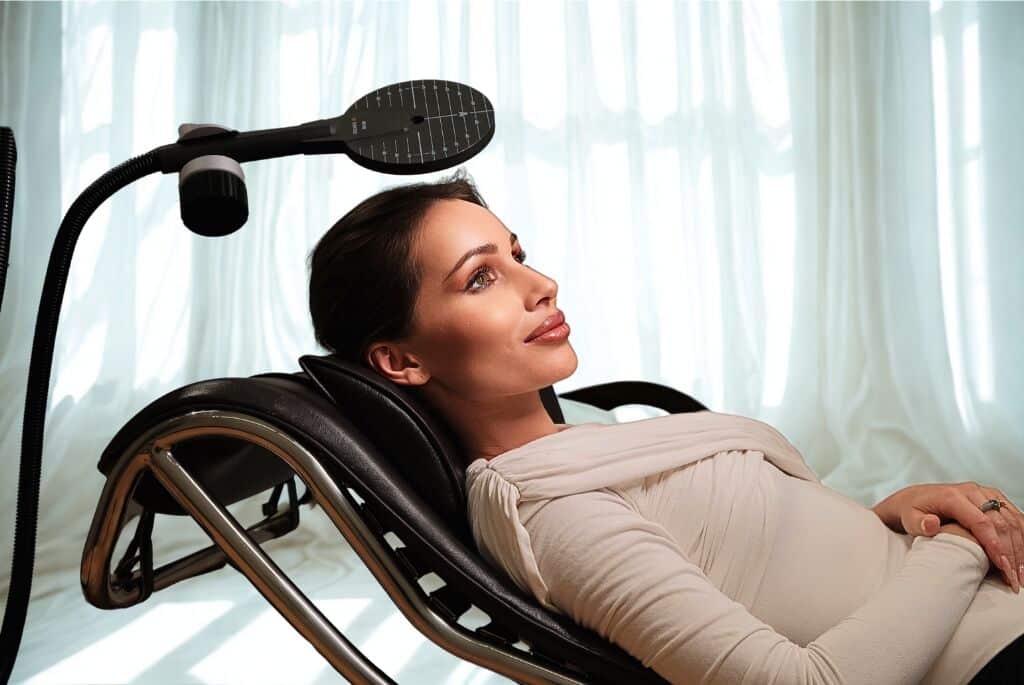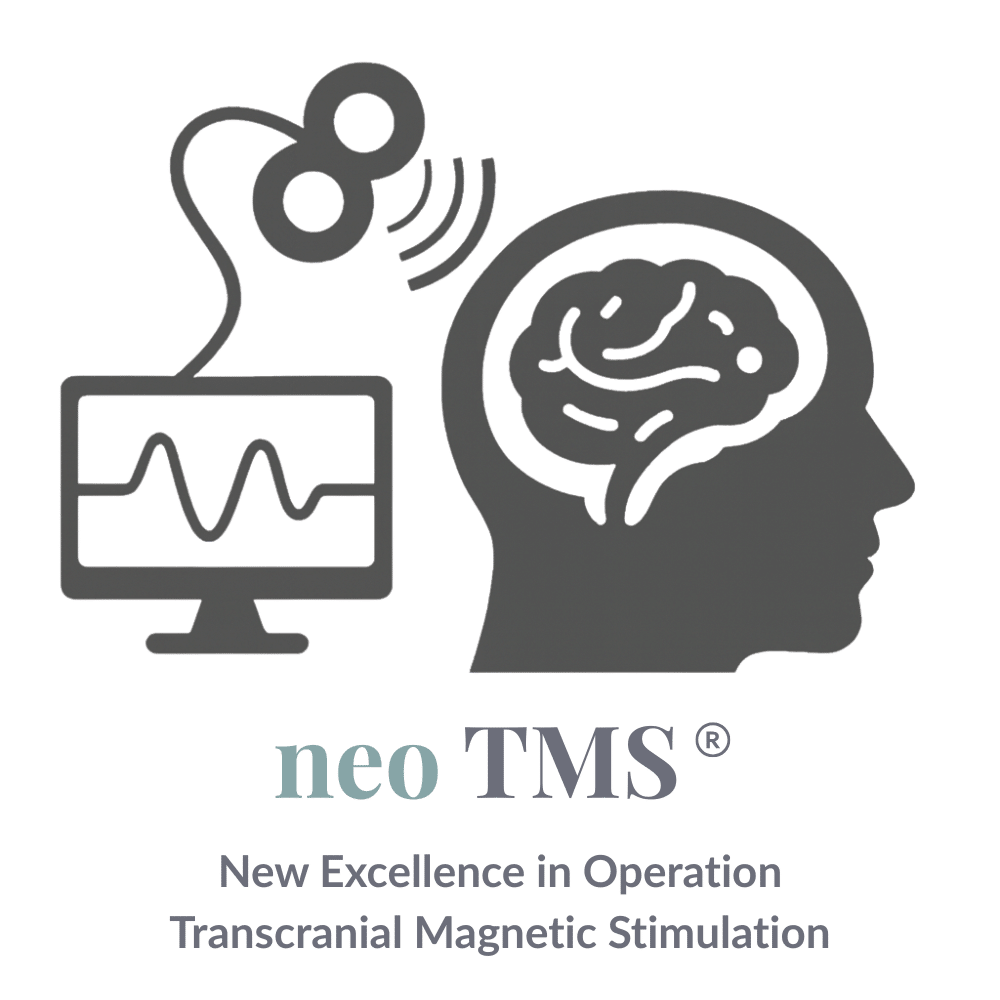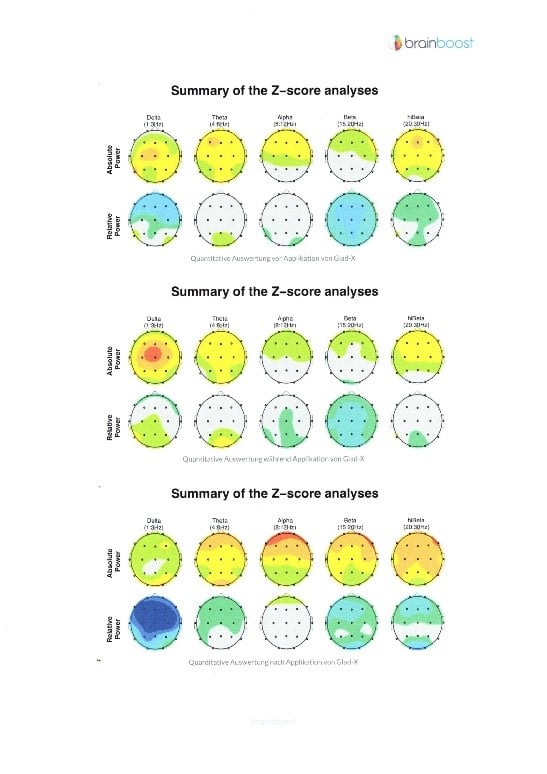Repetitive transcranial magnetic stimulation (rTMS) was initially developed for research purposes in the 1980s. This was followed by studies, mainly on the treatment of depression. The principle is based on electromagnetic induction. Where currents flow, there is also a corresponding magnetic flux. If a current-carrying coil is placed over the skull, the resulting magnetic field penetrates the skull and stimulates the nerve cells of the brain, which in turn react sensitively to currents and magnetic fields and transmit corresponding impulses. At the beginning of the investigations, it was believed that the magnetic field should be particularly strong in order to directly induce a current flow in the brain by changing the membrane voltages at the proximal axons (nerve cell processes), along which the current is transmitted to the synapses, where a transmitter is released and other nerve cells are in turn stimulated to transmit the current.
It has been shown that rTMS is a good alternative to medication for many patients.
With the exception of the treatment of depression / anxiety in depression / neuropathic pain / obsessive-compulsive disorder / rehabilitation after a stroke, the use of rTMS is actually off-label.
The effective treatment of the listed diseases is proven by international studies. You can follow the links provided to form your own opinion.
In addition, there are also isolated case reports that rTMS helps with some other conditions, such as emotional shock, psychogenic movement and gait disorders, psychogenic sensory disorders and psychogenic paralyses. However, this is only recommended in the hands of an experienced therapist.


We have developed particularly effective, in some cases exclusive and proven stimulation protocols based on our experience with many illnesses over the past 22 years. The success rate in terms of a reduction in depressive symptoms is high due to the individualised treatment.
We combine rTMS with a special type of EEG, known as quantitative EEG (QEEG). This brain mapping requires a special qualification. Together with our experience driven and study based Neuro Spa software algorythm we develop optimised and individualised rTMS therapy protocols and parameters: neo TMS ®
Protocols, some exclusively in our practices (depending on location):
High/low frequency, pulse monitoring:
Frequencies faster or slower than 5 Hertz. Thanks to our intensive experience, we have stimulation locations that are unique in the world. They are supplemented by a pulse monitoring system developed in-house.
One-day treatment:
Up to 20 sessions of theta burst (a combination of a fast and a slow frequency) in one day , combined with neuroplasticity boosters, which can immediately enhance the effect and make it more lasting.
SAINT 2.0:
Theta-Burst protocol modified by us and used worldwide. Up to 10 sessions per day Known by Bryan Johnson (Blueprint), among others:

Bi-local
Multi-local TMS applications are in vogue. Only a few centres have this option. Here is an example of a bi-local TMS session (treatment with 2 coils), which is used in my practice in certain cases. Such special protocols are the result of 20 years of intensive clinical experience:

Low-intensity / subthreshold:
Low-threshold, so-called subthreshold or low-intensity TMS is also of increasing interest for research and clinical use. We use unique mobile devices for therapy support. Further information on request.
Who is suitable for rTMS?
Most researchers only have experience with rTMS in the treatment of depression. In my practice, however, we have also investigated the procedure in numerous other illnesses and also in healthy people and have used it with very good results in some cases (‘off-label use’, *healing trial). German private health insurance companies reimburse the costs of the procedure for severe depression resistant to pharmacotherapy.
How does the treatment proceed?
The patient is placed in a comfortable resting position and the coil is positioned on the skull. The stimulation protocols are then set on the rTMS machine and the current flow through the coil is defined. The current pulses themselves are only perceived by the patient in the form of a clicking sound. The magnetic field generated and actually effective penetrates the skull completely painlessly. Only occasionally is there a harmless twitching of the superficial muscles. The duration of the session varies, usually between 3 and 30 minutes. Further session intervals are agreed with the doctor.
Who is not suitable for rTMS?
The usual contraindications for therapeutic magnetic fields apply, e.g. pregnancy, pacemakers, severe brain trauma, metal parts in the brain, brain tumours, leukaemia, etc.. In my opinion, these are often relative contraindications that should be clarified on a case-by-case basis.
Are there alternatives?
The probability of success of rTMS, e.g. for the reduction of depressive symptoms, is high with an individualised therapy concept. There are certainly other good methods (psychotropic drugs, psychotherapy, ECT, ketamine, etc…), but rTMS is my personal favourite due to its very good tolerability, high efficiency in the hands of experienced practitioners and often rapid effectiveness.
Are there side effects?
The procedure has been used in my practice for 22 years. Notable side effects are headaches and drowsiness, which are mild and short-lived at best.
Which functional diagnostic tools support individualised treatment?
The Quantitative Electro Encephalogram (QEEG) is a brain mapping technique in which deviations in brain frequencies can be measured and localised quite precisely:
The measurement of heart rate variability (HRV) provides indications of possible disturbances in the autonomic nervous system:


What means aiTMS?
By means of artificial intelligence we can base diagnostic and therapy on internationally accepted studies and individualize the protocol at the same time. This concept is world wide unique.
Does rTMS affect the genetic material (DNA)?
Yes – there are now a growing number of scientific studies showing that repetitive transcranial magnetic stimulation (rTMS) not only affects neuronal activity, but also alters gene expression, epigenetic markers and the genome of nerve cells in the brain:
- Epigenetic modifications & gene regulation:
Long-term histone acetylation: In an animal study, rTMS led to changes in histone modification – specifically increased histone acetylation – which activated epigenetic mechanisms for gene regulation in the brain
Global DNA methylation: In a mouse model of depressive behaviour, rTMS increased global DNA methylation in the hippocampus and frontal cortex, accompanied by changes in methylation at stress-related genes such as CRH. E.g. CRH - Changes in gene expression
Immediate-Early Genes (IEG): Single rTMS application rapidly increases IEGs such as c-Fos, Arc, Junb, Egr2, which are central to neuronal activation and synapse formation
Region- and protocol-dependent: Depending on the TMS protocol (iTBS vs. cTBS) and brain region (e.g. cortex, hippocampus), Spatial Transcriptomics was used to detect regulated gene expression. For example, cTBS broadly reduced gene expression in the cortex. Broad spectrum of effects: Short and longer-term rTMS protocols affect genes involved in neuronal plasticity, glutamatergic/GABAergic signalling, inflammatory pathways, ion transporters, mitochondrial function and myelination - Cell level & network level
c-Fos markers: Animal studies show that rTMS (especially at low intensity) alters the protein c-Fos in many brain regions (even outside the stimulation area) – indication of far-reaching gene activations
Dendrite remodelling: 5 Hz-rTMS stimulated dendritic spines in the frontal cortex and dentate gyrus – coupled with epigenetic control such as histone trimethylation and DNA methylation
Conclusion
- rTMS actively acts at the genome level in brain cells – from immediate transcriptional changes (IEGs) to permanent epigenetic markers (methylation, histone modification).
- In addition, scientific evidence suggests that electromagnetic stimulation (such as rTMS) influences epigenetic mechanisms such as DNA methylation and histone modifications – central processes in learning, memory formation and neuroplasticity.
- These effects are dependent on frequency, protocol, region and duration of stimulation and play a central role in neuronal plasticity, neuroregeneration and treatment of psychiatric and neurological disorders.
Understanding these mechanisms will help to develop rTMS in a more targeted way and as a precision biology therapy.
Can transplanted stem cells form new brain tissue?
Prof. Ulrich Sprick from Düsseldorf presented considerable research on this already in the 1990s:
Transient and long lasting beneficial behavioral effects of grafts in the damaged hippocampus of rat
Lon-term tracing of vital neurons with Hoechst 33342 in transplantation studies
Can rTMS promote stem cell growth?
There are some studies that prove the positive effect of rTMS on the growth of stem cells:
Does it make sense to combine rTMS with stem cell transplantation?
There are still no reliable studies on this. However, the approach sounds promising.
What else may boost rTMS?

